Home
| About
| Mine Tracker
| RSS
| Footer
▄▄▄▄▄▄▄▄▄▄▄▄▄▄▄▄▄▄▄▄▄▄▄▄▄▄▄▄▄▄▄▄▄▄▄▄▄▄▄▄▄▄▄▄▄▄▄▄▄▄▄▄▄▄▄▄▄▄▄▄▄▄▄▄▄▄▄▄▄▄▄▄▄▄▄▄▄▄▄▄▄▄▄▄▄▄▄▄▄▄▄▄▄▄▄▄ █▄▄░▄▄█░▄▄▀█░▄▄▀█▀▄▀█░▄▄███░▄▄▀█░▄▄▀█░▄▀███▄▄░▄▄█░▄▄▀█░▄▄▀█▀▄▀█░▄▄█░▄▄▀█░▄▄▀██▄██░███▄██▄░▄█░██░ ███░███░▀▀▄█░▀▀░█░█▀█░▄▄███░▀▀░█░██░█░█░█████░███░▀▀▄█░▀▀░█░█▀█░▄▄█░▀▀░█░▄▄▀██░▄█░███░▄██░██░▀▀░ ███░███▄█▄▄█▄██▄██▄██▄▄▄███▄██▄█▄██▄█▄▄██████░███▄█▄▄█▄██▄██▄██▄▄▄█▄██▄█▄▄▄▄█▄▄▄█▄▄█▄▄▄██▄██▀▀▀▄ ▀▀▀▀▀▀▀▀▀▀▀▀▀▀▀▀▀▀▀▀▀▀▀▀▀▀▀▀▀▀▀▀▀▀▀▀▀▀▀▀▀▀▀▀▀▀▀▀▀▀▀▀▀▀▀▀▀▀▀▀▀▀▀▀▀▀▀▀▀▀▀▀▀▀▀▀▀▀▀▀▀▀▀▀▀▀▀▀▀▀▀▀▀▀▀▀
Report; Reimagining the Seafood Import Monitoring Program
https://www.stimson.org/wp-content/uploads/2024/07/REPORT_Reimagining-SIMP-Session-2-StimsonFishWise.pdf
Many workshop participants supported the idea that digitizing supply chain records is crucial for effective and efficient risk analytics. Although SIMP was developed as a risk-based program, it still needs an underlying automated risk analytics platform to synthesize the enormous quantities of data provided by the seafood industry and link to external datasets or databases. Automated and digitized systems play a crucial role in enhancing risk analyses for seafood products by leveraging advanced technologies such as AI/ML to gather, analyze, and interpret large volumes of data efficiently. By processing data from multiple sources, including historical data, supply chain data, and third-party data, automated systems lend themselves to regular monitoring of risks that adapt to the evolving nature of seafood supply chains. These automated processes can also help identify patterns, anomalies, or outliers that might have otherwise gone unidentified by manual systems. By analyzing both historical data and current conditions, automated systems even have the potential to predict the likelihood of future risks, allowing for proactive risk management and targeted allocation of resources and enforcement efforts.
https://www.stimson.org/wp-content/uploads/2024/07/REPORT_Reimagining-SIMP-Session-2-StimsonFishWise.pdf
Many workshop participants supported the idea that digitizing supply chain records is crucial for effective and efficient risk analytics. Although SIMP was developed as a risk-based program, it still needs an underlying automated risk analytics platform to synthesize the enormous quantities of data provided by the seafood industry and link to external datasets or databases. Automated and digitized systems play a crucial role in enhancing risk analyses for seafood products by leveraging advanced technologies such as AI/ML to gather, analyze, and interpret large volumes of data efficiently. By processing data from multiple sources, including historical data, supply chain data, and third-party data, automated systems lend themselves to regular monitoring of risks that adapt to the evolving nature of seafood supply chains. These automated processes can also help identify patterns, anomalies, or outliers that might have otherwise gone unidentified by manual systems. By analyzing both historical data and current conditions, automated systems even have the potential to predict the likelihood of future risks, allowing for proactive risk management and targeted allocation of resources and enforcement efforts.
An Overview of Shrimp and its Sustainability in 2024
https://sustainablefisheries-uw.org/shrimp-sustainability-2024/
Despite this steadily growing demand domestically and abroad, wild and farmed shrimp production has inherent, well-reported issues that make sustainability challenging. Consumers are more aware of these issues than ever, with considerable media attention given to the environmental and social challenges in recent years. Grocery retail buyers are responding by requiring minimum environmental certifications and labor standards for their suppliers. But how are these new criteria keeping up with demand? How sustainable is global shrimp production in 2024?
https://sustainablefisheries-uw.org/shrimp-sustainability-2024/
Despite this steadily growing demand domestically and abroad, wild and farmed shrimp production has inherent, well-reported issues that make sustainability challenging. Consumers are more aware of these issues than ever, with considerable media attention given to the environmental and social challenges in recent years. Grocery retail buyers are responding by requiring minimum environmental certifications and labor standards for their suppliers. But how are these new criteria keeping up with demand? How sustainable is global shrimp production in 2024?
Article: Met Oeigoerse dwangarbeid gemaakte vis ligt ook in Nederlandse schappen
https://www.nu.nl/economie/6285253/met-oeigoerse-dwangarbeid-gemaakte-vis-ligt-ook-in-nederlandse-schappen.html
Zo krijgen Nederlandse importeurs onder andere kabeljauw, tong en koolvis geleverd van Chinese bedrijven die gebruikmaken van dwangarbeid. Het gaat om mensen uit de West-Chinese regio Xinjiang, waar veel Oeigoeren wonen die door de Chinese staat zwaar worden onderdrukt. Zij worden uit hun regio weggehaald en moeten verplicht aan de slag bij de visserijbedrijven.
https://www.nu.nl/economie/6285253/met-oeigoerse-dwangarbeid-gemaakte-vis-ligt-ook-in-nederlandse-schappen.html
Zo krijgen Nederlandse importeurs onder andere kabeljauw, tong en koolvis geleverd van Chinese bedrijven die gebruikmaken van dwangarbeid. Het gaat om mensen uit de West-Chinese regio Xinjiang, waar veel Oeigoeren wonen die door de Chinese staat zwaar worden onderdrukt. Zij worden uit hun regio weggehaald en moeten verplicht aan de slag bij de visserijbedrijven.
Outlaw Ocean: The China Report
https://www.theoutlawocean.com/investigations/china-the-superpower-of-seafood/
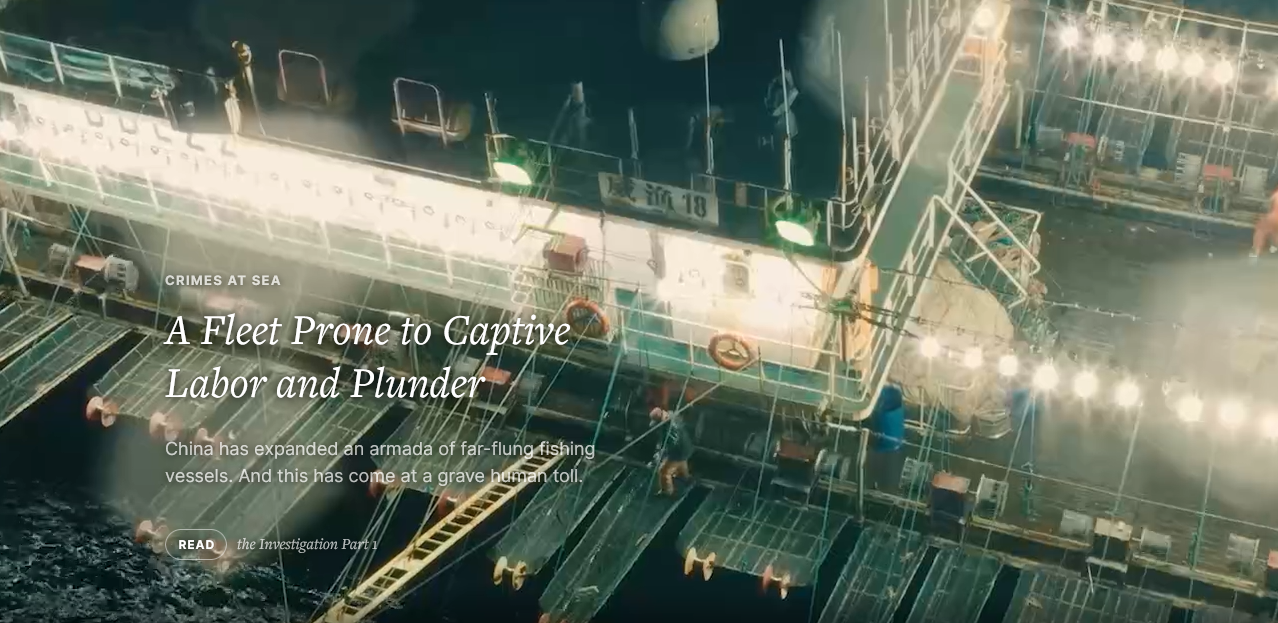
Since then, China has invested heavily in its fleet. The country now catches more than five billion pounds of seafood a year through distant-water fishing, the biggest portion of it squid. China’s seafood industry, which is estimated to be worth more than thirty-five billion dollars, accounts for a fifth of the international trade, and has helped create fifteen million jobs. The Chinese state owns much of the industry—including some twenty per cent of its squid ships—and oversees the rest through the Overseas Fisheries Association. Today, the nation consumes more than a third of the world’s fish.
https://www.theoutlawocean.com/investigations/china-the-superpower-of-seafood/

Since then, China has invested heavily in its fleet. The country now catches more than five billion pounds of seafood a year through distant-water fishing, the biggest portion of it squid. China’s seafood industry, which is estimated to be worth more than thirty-five billion dollars, accounts for a fifth of the international trade, and has helped create fifteen million jobs. The Chinese state owns much of the industry—including some twenty per cent of its squid ships—and oversees the rest through the Overseas Fisheries Association. Today, the nation consumes more than a third of the world’s fish.
PDF, Final checklist for traceability in seafood
https://media.salttraceability.org/wp-content/uploads/2022/12/09143734/Final_Checklist_for_Governments_SALT_12_9_22.pdf

This checklist was developed to support governments in designing and implementing lasting and scalable traceability systems in their seafood sectors. It compiles insights and advice gleaned from traceability experts from five continents and 32 published resources and case studies. After reviewing findings for common themes and factors that influenced or interfered with traceability, this checklist was created for governments to consider, use, and revisit to avoid others’ “glorious failures” and work towards effective solutions. Scalable and lasting seafood traceability can be achieved by adhering to an iterative, 4-stage process outlined in this checklist and in conjunction with the Comprehensive Traceability Principles and Pathway.
https://media.salttraceability.org/wp-content/uploads/2022/12/09143734/Final_Checklist_for_Governments_SALT_12_9_22.pdf

This checklist was developed to support governments in designing and implementing lasting and scalable traceability systems in their seafood sectors. It compiles insights and advice gleaned from traceability experts from five continents and 32 published resources and case studies. After reviewing findings for common themes and factors that influenced or interfered with traceability, this checklist was created for governments to consider, use, and revisit to avoid others’ “glorious failures” and work towards effective solutions. Scalable and lasting seafood traceability can be achieved by adhering to an iterative, 4-stage process outlined in this checklist and in conjunction with the Comprehensive Traceability Principles and Pathway.
Fish4Ever Traceability
https://fish4ever.co.uk/

In the local eco-shop I bought a tin of mackerel from Fish4Ever for no other reason than that it promised traceability of the fish back to the boat that caught it. I had not heard of this company/advocacy group before but from this somewhat older interview I learned that they are also campaigning for MSC to be more strict on some aspects of fisheries. Earlier I looked at the same functionality offered by John West.


The code takes me to this page which contains not just a deep level of factual information on this fishery (species, catching method, catching area) but also a detailed statement on why they sell this particular mackerel even while it lost its MSC certification, this again branching out in the wider implications of climate change and conflicts in governance in relation to conversation areas.
This is a really good source of information on a product level, especially when you compare it with John West. It you are going to be annoying I would say that traceability is not just about showing the physical source but the entire chain: who processed and canned, storage points, age of the product. It’s not easy, but if we are looking for the avant-garde of traceability that is what we look for. Fish4Ever does has an informative page on their Quality Charter. Point 2 “We will always use the shortest possible supply chain” is relevant here, but again: show it! But I am not complaining this is a really nice traceability service that can serve as an example to many others. What I also like about it is that the traceability is so central to their value proposition. Really Cool.
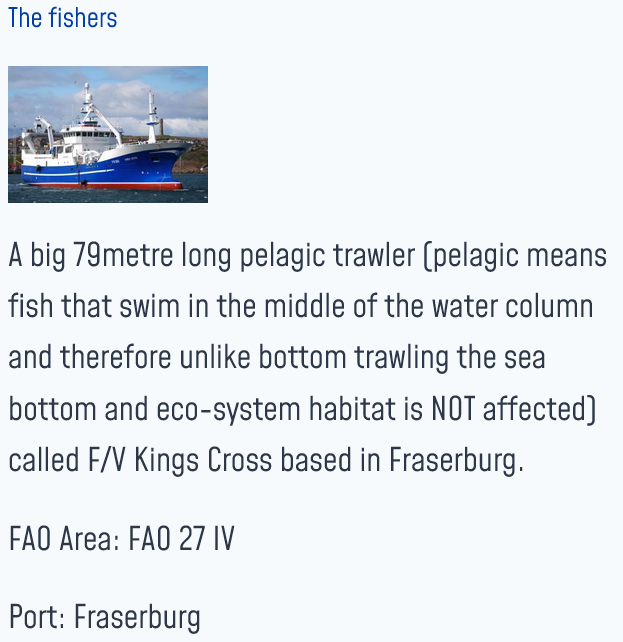
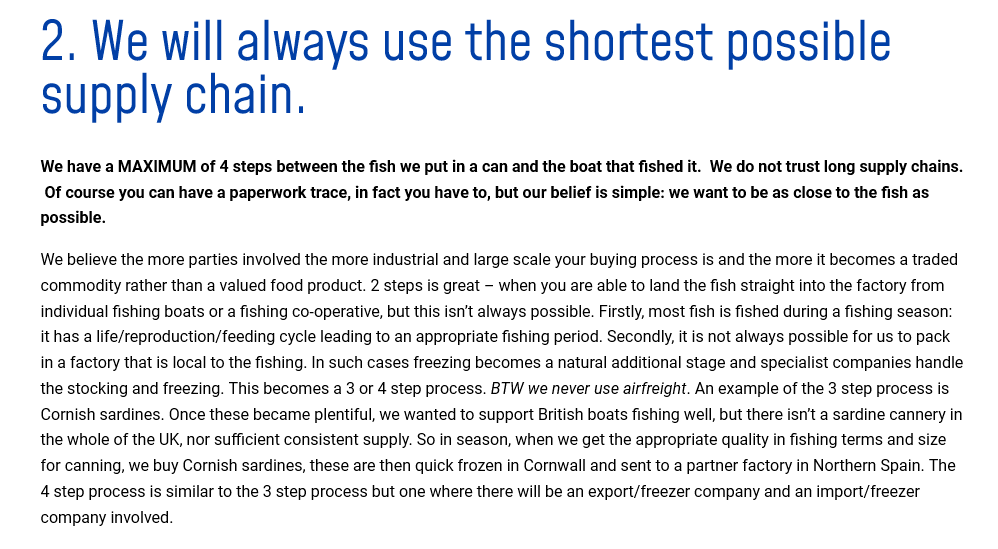
https://fish4ever.co.uk/

In the local eco-shop I bought a tin of mackerel from Fish4Ever for no other reason than that it promised traceability of the fish back to the boat that caught it. I had not heard of this company/advocacy group before but from this somewhat older interview I learned that they are also campaigning for MSC to be more strict on some aspects of fisheries. Earlier I looked at the same functionality offered by John West.


The code takes me to this page which contains not just a deep level of factual information on this fishery (species, catching method, catching area) but also a detailed statement on why they sell this particular mackerel even while it lost its MSC certification, this again branching out in the wider implications of climate change and conflicts in governance in relation to conversation areas.
This is a really good source of information on a product level, especially when you compare it with John West. It you are going to be annoying I would say that traceability is not just about showing the physical source but the entire chain: who processed and canned, storage points, age of the product. It’s not easy, but if we are looking for the avant-garde of traceability that is what we look for. Fish4Ever does has an informative page on their Quality Charter. Point 2 “We will always use the shortest possible supply chain” is relevant here, but again: show it! But I am not complaining this is a really nice traceability service that can serve as an example to many others. What I also like about it is that the traceability is so central to their value proposition. Really Cool.


Book, The Outlaw Ocean
https://en.wikipedia.org/wiki/The_Outlaw_Ocean

The dark underbelly of supply chains
https://en.wikipedia.org/wiki/The_Outlaw_Ocean

The dark underbelly of supply chains
WWF, Traceability principles for wild-caught fish products
https://wwfint.awsassets.panda.org/downloads/wwf_traceability_principles_for_wild_caught_fish_products_.pdf

Principle 1 — Essential Information
All wild-caught fish product traceability systems should provide rapid access to reliable information that is efficient to assess the compliance of the fish product under consideration with all applicable legal requirements.
Principle 2 — Full Chain Traceability
All wild-caught fish product traceability systems should be able to provide “full chain” traceability from the point of catch to the point of final sale, and should be able to establish a verifiable and complete chain of custody/ownership of the product as it moves through the supply chain.
Principle 3 — Effective Tracking of Product Transformations
All wild-caught fish product traceability systems should record tracking of product transformations and information on the location of product sufficiently to ensure that the legal origin of products can be readily established at the final point of sale, and that claims related to sustainability or fishing methods are readily verifiable.
Principle 4 — Digital Information and Standardized Data Formats
Wild-caught fish product traceability systems should employ electronic recording of data, labelling, and tracking in standard data formats from point of capture to point of final sale.
Principle 5 — Verification
All wild-caught fish product traceability systems, and all claims based on them, must be subject to credible and transparent external verification mechanisms and regular independent audits, including effective governmental oversight and enforcement as well as, where applicable, credible third-party verification.
Principle 6 — Transparency and Public Access to Information
All wild-caught fish product traceability systems should be as transparent as possible and should provide consumers and other stakeholders the information needed to inform responsible choices
https://wwfint.awsassets.panda.org/downloads/wwf_traceability_principles_for_wild_caught_fish_products_.pdf

Principle 1 — Essential Information
All wild-caught fish product traceability systems should provide rapid access to reliable information that is efficient to assess the compliance of the fish product under consideration with all applicable legal requirements.
Principle 2 — Full Chain Traceability
All wild-caught fish product traceability systems should be able to provide “full chain” traceability from the point of catch to the point of final sale, and should be able to establish a verifiable and complete chain of custody/ownership of the product as it moves through the supply chain.
Principle 3 — Effective Tracking of Product Transformations
All wild-caught fish product traceability systems should record tracking of product transformations and information on the location of product sufficiently to ensure that the legal origin of products can be readily established at the final point of sale, and that claims related to sustainability or fishing methods are readily verifiable.
Principle 4 — Digital Information and Standardized Data Formats
Wild-caught fish product traceability systems should employ electronic recording of data, labelling, and tracking in standard data formats from point of capture to point of final sale.
Principle 5 — Verification
All wild-caught fish product traceability systems, and all claims based on them, must be subject to credible and transparent external verification mechanisms and regular independent audits, including effective governmental oversight and enforcement as well as, where applicable, credible third-party verification.
Principle 6 — Transparency and Public Access to Information
All wild-caught fish product traceability systems should be as transparent as possible and should provide consumers and other stakeholders the information needed to inform responsible choices
Traceability systems in the CITES context
https://cites.org/sites/default/files/eng/prog/shark/docs/BodyofInf12.pdf

"Traceability systems in the CITES context: A review of experiences, best practices and lessons learned for the traceability of commodities of CITES- listed shark species" (2015) by Victoria Mundy and Glenn Sant is really interesting overview of approaches to traceability with multiple examples (caviar, timber, crocodile skins) giving you a good scope about implementation details about various traceability systems.


https://cites.org/sites/default/files/eng/prog/shark/docs/BodyofInf12.pdf

"Traceability systems in the CITES context: A review of experiences, best practices and lessons learned for the traceability of commodities of CITES- listed shark species" (2015) by Victoria Mundy and Glenn Sant is really interesting overview of approaches to traceability with multiple examples (caviar, timber, crocodile skins) giving you a good scope about implementation details about various traceability systems.


Why tracing seafood from sea to plate is the next frontier in sustainability
https://www.worldwildlife.org/stories/why-tracing-seafood-from-sea-to-plate-is-the-next-frontier-in-sustainability
Traceability starts with attaching to each fish caught a set of information such as where and when the fish was caught, the name of the fishing boat, the license it carries, and the type of gear the fishers used. Detailed data are essential because tracing seafood from sea to plate is not a simple proposition. Global supply chains in this massive industry are complex; some fish might pass through a dozen different companies and several countries before reaching a dinner plate. Ensuring that traded fish have a detailed and connected data trail to their origin is the best way to inform assessments of a fishery’s impact on the environment and its labor practices. But there is no way to trace products through such complex journeys without a uniform standard for digital data collection and sharing. That’s why WWF spent years working with dozens of companies around the world to create the Global Dialogue on Seafood Traceability standards.
https://www.worldwildlife.org/stories/why-tracing-seafood-from-sea-to-plate-is-the-next-frontier-in-sustainability
Traceability starts with attaching to each fish caught a set of information such as where and when the fish was caught, the name of the fishing boat, the license it carries, and the type of gear the fishers used. Detailed data are essential because tracing seafood from sea to plate is not a simple proposition. Global supply chains in this massive industry are complex; some fish might pass through a dozen different companies and several countries before reaching a dinner plate. Ensuring that traded fish have a detailed and connected data trail to their origin is the best way to inform assessments of a fishery’s impact on the environment and its labor practices. But there is no way to trace products through such complex journeys without a uniform standard for digital data collection and sharing. That’s why WWF spent years working with dozens of companies around the world to create the Global Dialogue on Seafood Traceability standards.
ThisFish, Company Website
https://this.fish/
ThisFish Inc. is an emerging leader in seafood traceability software, increasing trust and transparency in the supply chain. We enable you to make informed choices rewarding those who responsibly harvest.
https://this.fish/
ThisFish Inc. is an emerging leader in seafood traceability software, increasing trust and transparency in the supply chain. We enable you to make informed choices rewarding those who responsibly harvest.
FishWise, Company Website
https://fishwise.org/
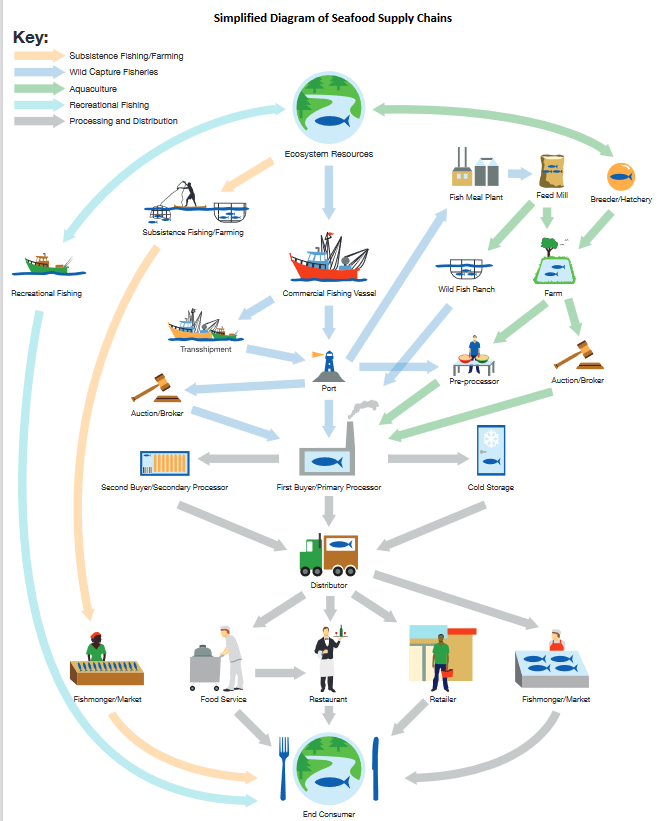
Fisheries and aquaculture provide a vital source of nutrition and livelihoods for billions of people worldwide, but the complexity of seafood supply chains allow for major environmental and social challenges. Seafood stakeholders need clear information and practical guidance to take action to address these problems. FishWise is a seafood industry compass, providing innovative market-based tools and expertise in sustainability services, human rights action, and traceability best practices.
https://fishwise.org/

Fisheries and aquaculture provide a vital source of nutrition and livelihoods for billions of people worldwide, but the complexity of seafood supply chains allow for major environmental and social challenges. Seafood stakeholders need clear information and practical guidance to take action to address these problems. FishWise is a seafood industry compass, providing innovative market-based tools and expertise in sustainability services, human rights action, and traceability best practices.
Article: Finding Sustainable Seafood Can Be Complex
https://www.bbc.com/future/article/20220810-can-eating-fish-ever-be-sustainable
Although this article does not spell it out, the implication for an end consumer wanting to buy sutainable will always rely on the product having traceability requirements. Certification is the best mechanism and signal we currently have for supply chains managers and consumers alike to achieve and verify this.
https://www.bbc.com/future/article/20220810-can-eating-fish-ever-be-sustainable
Although this article does not spell it out, the implication for an end consumer wanting to buy sutainable will always rely on the product having traceability requirements. Certification is the best mechanism and signal we currently have for supply chains managers and consumers alike to achieve and verify this.
"[The Marine Stewardship Council blue tick] means at least they are being audited, and they have to prove things," says Clarke. "It's a great way of just quickly and easily identifying whether something's a sustainable choice."
Certifications like these can also be a protection against fraud, a huge issue in the seafood industry.
A 2016 meta-analysis of DNA identification studies of seafood found that globally there was a 30% rate of misdescription – meaning the fish was not the species stated on the label or menu. But a 2019 DNA study by the Marine Stewardship Council found that seafood bearing its sustainability mark was labelled correctly over 99% of the time.
One issue with these labels, however, is that gaining them can be a significant process for a fishery involving data collection and a lot of paperwork – meaning not every fishery has the resources to receive the stamp, even if they are working sustainably.
The 11 sins of seafood: Assessing a decade of food fraud reports in the global supply chain
https://ift.onlinelibrary.wiley.com/doi/10.1111/1541-4337.12998
Due to complex, valuable, and often extremely opaque supply chains, seafood is a commodity that has experienced a high prevalence of food fraud throughout the entirety of its logistics network. Fraud detection and prevention require an in-depth understanding of food supply chains and their vulnerabilities and risks so that food business operators, regulators, and other stakeholders can implement practical countermeasures. An analysis of historical criminality within a sector, product, or country is an important component and has not yet been conducted for the seafood sector. This study examines reported seafood fraud incidents from the European Union's Rapid Alert System for Food and Feed, Decernis's Food Fraud Database, HorizonScan, and LexisNexis databases between January 01, 2010 and December 31, 2020.
https://ift.onlinelibrary.wiley.com/doi/10.1111/1541-4337.12998
Due to complex, valuable, and often extremely opaque supply chains, seafood is a commodity that has experienced a high prevalence of food fraud throughout the entirety of its logistics network. Fraud detection and prevention require an in-depth understanding of food supply chains and their vulnerabilities and risks so that food business operators, regulators, and other stakeholders can implement practical countermeasures. An analysis of historical criminality within a sector, product, or country is an important component and has not yet been conducted for the seafood sector. This study examines reported seafood fraud incidents from the European Union's Rapid Alert System for Food and Feed, Decernis's Food Fraud Database, HorizonScan, and LexisNexis databases between January 01, 2010 and December 31, 2020.
Case Study: John West Traceability App
https://www.john-west.co.uk/sustainability/trace-your-plate/

John West is promoting a ‘100% traceable’ solution for a number of their canned products.

The app asks to enter a barcode (5000171053312) and a can number (1922).

Since 2014 it is mandatory in the EU that information on production method, fishing gear, catch area, common and latin species names are recorded on the packaging of fish products. So apart from the fishing vessel this solution is not giving away any information John West is not legally required to disclose anyway. Although I have not yet found the latin name mentioned anywhere unless you need to dive as far as the sustainability report (pdf).
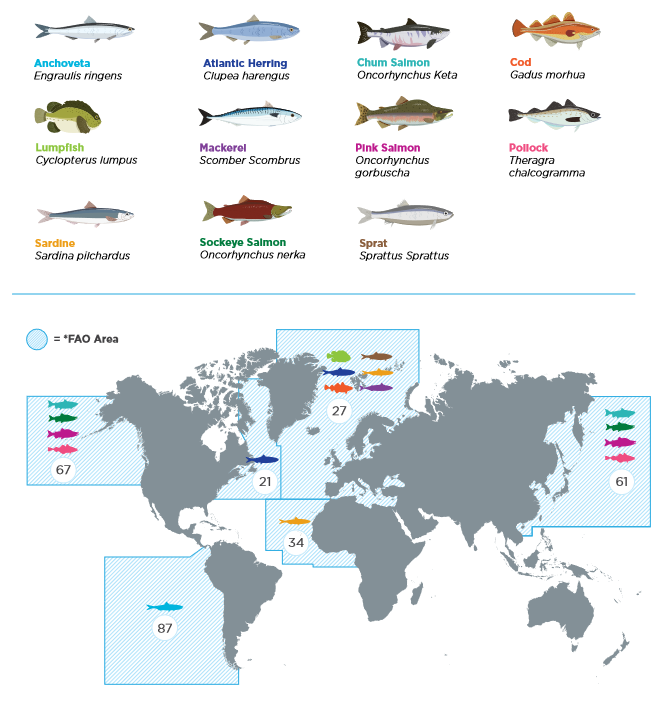
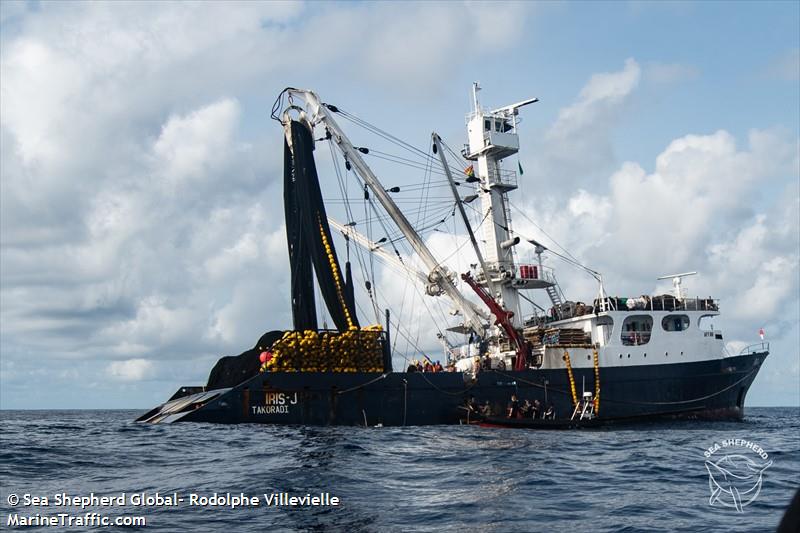
Knowing the name of the vessel that caught your fish is a nice feature, and there exist a number of online shipping tools that allow you to explore it. For instance, it is registered in Ghana and was built in 1983. Marinetraffic even has a picture (ominously with a Sea Shepherd logo).
Note that the traceability information for this product comes without any explanation on verification. Who manages these systems, how accurate are they, are they audited? Information like date of harvest, or the location of canning, are not legally required to be published but are crucial to traceability. Having said that, I happen to be interested in the nuts and bolts of these systems, but for a ‘normal’ consumer this might be a value enhancing addition to a supermarket product.
https://www.john-west.co.uk/sustainability/trace-your-plate/

John West is promoting a ‘100% traceable’ solution for a number of their canned products.

The app asks to enter a barcode (5000171053312) and a can number (1922).

Since 2014 it is mandatory in the EU that information on production method, fishing gear, catch area, common and latin species names are recorded on the packaging of fish products. So apart from the fishing vessel this solution is not giving away any information John West is not legally required to disclose anyway. Although I have not yet found the latin name mentioned anywhere unless you need to dive as far as the sustainability report (pdf).


Knowing the name of the vessel that caught your fish is a nice feature, and there exist a number of online shipping tools that allow you to explore it. For instance, it is registered in Ghana and was built in 1983. Marinetraffic even has a picture (ominously with a Sea Shepherd logo).
Note that the traceability information for this product comes without any explanation on verification. Who manages these systems, how accurate are they, are they audited? Information like date of harvest, or the location of canning, are not legally required to be published but are crucial to traceability. Having said that, I happen to be interested in the nuts and bolts of these systems, but for a ‘normal’ consumer this might be a value enhancing addition to a supermarket product.
WholeChain, Company Website
https://wholechain.com/
Wholechain is a blockchain based traceability solution built to enable trust, coordination, and transparency in fragmented supply chains.
https://wholechain.com/
Wholechain is a blockchain based traceability solution built to enable trust, coordination, and transparency in fragmented supply chains.
Transparency in Seafood
https://oceandisclosureproject.org/
Discover the origin and environmental sustainability of wild-caught and farmed seafood sourced by seafood businesses throughout the supply chain.
https://oceandisclosureproject.org/
Discover the origin and environmental sustainability of wild-caught and farmed seafood sourced by seafood businesses throughout the supply chain.
A pocket guide to the EU’s new fish and aquaculture consumer labels
https://trade.ec.europa.eu/doclib/docs/2014/december/tradoc_152941.pdf

Within the EU fish comes with basic traceability requirements. This pocket guide will explain what must appear on the new labels and what additional information can be displayed.
https://trade.ec.europa.eu/doclib/docs/2014/december/tradoc_152941.pdf

Within the EU fish comes with basic traceability requirements. This pocket guide will explain what must appear on the new labels and what additional information can be displayed.
Marin Trust
https://www.marin-trust.com/
Independent third-party audit and certification programme, allowing producers to demonstrate that marine ingredients are responsibly sourced & produced. Chain of Custody certifification included.
https://www.marin-trust.com/
Independent third-party audit and certification programme, allowing producers to demonstrate that marine ingredients are responsibly sourced & produced. Chain of Custody certifification included.
The seafood supply chain from a fraudulent perspective
https://link.springer.com/article/10.1007/s12571-018-0826-z

Seafood is one commodity which has endured extensive fraudulent activity owing to its increasing consumer demand, resource limitations, high value and complex supply chains. It is essential that these fraudulent opportunities are revealed, the risk is evaluated and countermeasures for mitigation are assigned. This can be achieved through mapping of the seafood supply chains and identifying the vulnerability analysis critical control points (VACCP), which can be exposed, infiltrated and exploited for fraudulent activity. This research systematically maps the seafood supply chain for three key commodities: finfish, shellfish and crustaceans in the United Kingdom. Each chain is comprised of multiple stakeholders across numerous countries producing a diverse range of products distributed globally.
https://link.springer.com/article/10.1007/s12571-018-0826-z

Seafood is one commodity which has endured extensive fraudulent activity owing to its increasing consumer demand, resource limitations, high value and complex supply chains. It is essential that these fraudulent opportunities are revealed, the risk is evaluated and countermeasures for mitigation are assigned. This can be achieved through mapping of the seafood supply chains and identifying the vulnerability analysis critical control points (VACCP), which can be exposed, infiltrated and exploited for fraudulent activity. This research systematically maps the seafood supply chain for three key commodities: finfish, shellfish and crustaceans in the United Kingdom. Each chain is comprised of multiple stakeholders across numerous countries producing a diverse range of products distributed globally.
A seafood risk tool for chemical and pathogen hazards in the aquaculture supply chain
https://www.nature.com/articles/s43016-022-00465-3#MOESM1
The Seafood Risk Tool (SRT) described here allows detailed profiling of the uncontrolled and controlled impact of these diverse hazards at six key phases in the seafood supply chain. When applied to specific national or subnational aquaculture scenarios (for example, for production of a given species from a defined location, with products destined for designated markets and end uses), the SRT can perform a critical function for national governments by supporting conditions for high animal health status and conditions for trade and safe consumption—core components of the One Health approach to aquaculture and integral within strategies aiming to nourish nations with "blue foods"
https://www.nature.com/articles/s43016-022-00465-3#MOESM1
The Seafood Risk Tool (SRT) described here allows detailed profiling of the uncontrolled and controlled impact of these diverse hazards at six key phases in the seafood supply chain. When applied to specific national or subnational aquaculture scenarios (for example, for production of a given species from a defined location, with products destined for designated markets and end uses), the SRT can perform a critical function for national governments by supporting conditions for high animal health status and conditions for trade and safe consumption—core components of the One Health approach to aquaculture and integral within strategies aiming to nourish nations with "blue foods"
Seafood Alliance for Legality and Traceability (SALT)
https://www.salttraceability.org/
SALT promotes legal and sustainable fisheries by expanding electronic traceability to benefit our ocean economy, environment, and seafood laborers
https://www.salttraceability.org/
SALT promotes legal and sustainable fisheries by expanding electronic traceability to benefit our ocean economy, environment, and seafood laborers
Global Dialogue on Seafood Traceability (GDST)
https://traceability-dialogue.org
The GDST is an international, business-to-business platform established in 2017 to create the first-ever global industry standards for seafood traceability.
https://traceability-dialogue.org
The GDST is an international, business-to-business platform established in 2017 to create the first-ever global industry standards for seafood traceability.